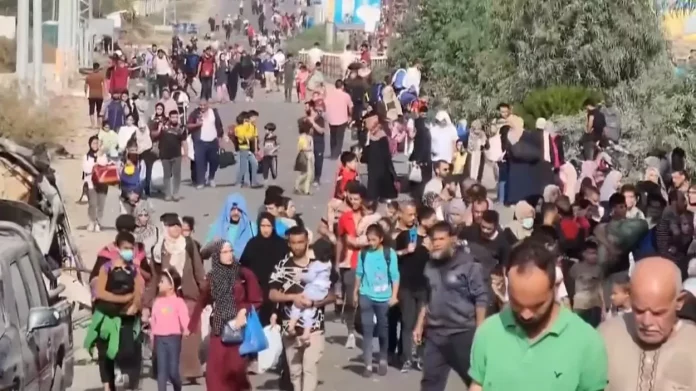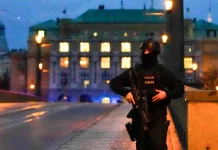As the world watches, Israeli soldiers push deeper into Gaza City, where they face fierce resistance from Hamas fighters in densely populated areas where many Palestinians are hiding.
The Israeli army is now fighting street by street, putting civilians at risk. Israel claims that Hamas uses civilians as human shields, but this claim has not reduced the international criticism of Israel’s actions.
The army said it was targeting the core of Hamas’s military and intelligence operations in a part of Gaza City near Al-Shifa hospital, the largest medical facility in the strip. The area, according to the army, contained a command center, a training camp and weapons factories that produced rockets, antitank missiles, drones and other explosives. The army also said there were kindergartens and mosques in the vicinity.
The intensifying violence is forcing many Gazans to flee southward, creating a humanitarian crisis for aid workers who are struggling to provide them with shelter. The United Nations says that more than 557,000 people are staying in its facilities in southern Gaza, but the facilities are already full. The U.N. also said that there was only one toilet for every 160 people at the shelters.”
On Thursday, an international conference was held by French President Emmanuel Macron to improve the delivery of aid and medical care. France and Egypt have provided ships and field hospitals, respectively, but they are difficult to access due to the border restrictions and the turmoil caused by the conflict.
Macron said in his opening speech on Thursday that “the situation is grave and is deteriorating every day.” He said that “the priority is to protect the civilians. For that, we need a quick humanitarian pause and we need to work towards a cease-fire.”
The Egyptian Foreign Minister Sameh Shoukry said at the Paris meeting that “the actions of the Israeli government go beyond the right of self-defense.”
The Palestinian Authority’s Prime Minister, Mohammad Shtayyeh, said that Israel’s war was not with Hamas, but with the entire Palestinian population. He asked, “How many Palestinians have to die for the war to end?”
Israel’s military said on X, the former Twitter, that “our war is with Hamas and not with the people of Gaza.”

On Thursday, a new video of hostages was released with the logo of Palestinian Islamic Jihad, a militant group that supports Hamas. It showed an old woman from a kibbutz, who seemed to be in a wheelchair, and a boy who claimed to be 13 years old.
“Media outlets are urged not to broadcast such videos, which the Israeli military spokesman called “the worst kind of psychological terror”.
On Thursday, the IDF seized a part of the Jabalia refugee camp, north of Gaza City, after a 10-hour clash with Hamas in the tunnels and streets that have turned into ruins. The Israel Defense Forces released pictures of the battle, showing Israeli soldiers fighting among collapsed buildings, supported by tanks and armored bulldozers that made a way through the debris. The Israeli military said it found weapons and tunnel entrances.
The Israeli military said its ground troops attacked a main Hamas military base in the center of Gaza City, near the Al-Shifa hospital complex.
The Israeli military said that in the past few days, the infantry and armored brigades, with air force backup, had fierce fights with Hamas in what it named the “military zone” of the group, and killed 50 Hamas fighters in the fight.
The U.S. is pushing Israel to let more humanitarian aid in and to give safe passage to civilians who are stuck. The U.S. said on Thursday that Israel agreed to stop its bombing of northern Gaza for four hours every day. Washington supports what it calls “humanitarian breaks” to create a chance for aid to enter.”
“Israel rejected Washington’s statement, saying that it would not change its current actions. Israel has let civilians escape on the main road from north Gaza for a few hours in the past days.
“These are temporary local breaks for humanitarian aid, which are restricted in time and place,” said Richard Hecht, a spokesperson for the IDF. “There’s no change.”
The conflict has moved to the center of the area’s main source of life: hospitals. According to doctors and the health ministry in Gaza, Al-Shifa hospital has been sheltering tens of thousands of Palestinians, who are living in the hallways of the large complex that is facing severe shortages of fuel, medicine, antiseptics and other supplies. Video footage from inside Al-Shifa showed patients being treated on the hospital ground, some with infected wounds.
Another Gaza City hospital, Al Quds, closed down important services on Wednesday because of a lack of fuel for generators, the U.N. said. The U.N. also said that the Al Awda hospital, the only place that offers maternity services in north Gaza, warned about a possible shutdown.
Palestinian Authority Health Minister Mai al-Kaila, who works in Ramallah in the West Bank, said that doctors in Gaza had to choose who to treat because of a lack of medical supplies. “They have to decide which patient…can survive and who can’t,” al-Kaila said. She added that some 198 medical professionals have died in Gaza since the war started.
Medical staff are afraid that the hospitals will be attacked directly. Israel says it has given intelligence to Western allies that shows that Gaza hospitals are built over a network of tunnels that provide Hamas militants with fuel and weapons. The Israeli military says that a key center of command and control is at Al-Shifa hospital, where Hamas leaders launch rocket attacks and other attacks.
Hamas has denied the Israeli claims, saying that Gaza hospitals are only used for emergency medical care. Hamas officials say that Israel is trying to make civilians leave hospital areas as part of a plan of mass displacement that aims to push Gazans out of their homes.
Al-Kaila said there was no proof that Hamas was hiding military facilities in Gaza’s hospitals.
Al-Shifa got only its second delivery of medical supplies, from the World Health Organization, this week since the war began. The U.N. said that there are about two patients for every bed at the hospital. With the emergency department and wards full, doctors have to treat the wounded in hallways, on the floor and outside.
“The number of wounded grows by the hour while patients are suffering a lot of unnecessary pain as medicines and anesthetics are running out,” the U.N. said Wednesday.
No bakeries are working in the north because of a lack of fuel, water and flour and no food or bottled water has been given there in a week, the U.N. says.
People who have left their homes in Gaza are living in poor conditions in U.N. shelters, Philippe Lazzarini, commissioner general of the U.N. agency for Palestinian refugees, said at the Paris meeting.
“Pushing a million people out of their homes and putting them in areas without proper infrastructure is forced displacement. Severely limiting food, water and medicine is collective punishment,” Lazzarini said.”
“As the Gaza Strip faces a fuel crisis, the U.N. is negotiating with Israel to allow fuel supplies into the territory, according to sources close to the matter. The U.N. would oversee the distribution of fuel within Gaza, to prevent it from falling into the hands of Hamas, the sources said.
However, the U.N. rejected Israel’s proposal to create a safe zone near the beach at the south west corner of Gaza, saying that there were no facilities there to host the population.
A former Israeli general and national security adviser, Giora Eiland, urged the Israeli forces to continue their offensive and exploit Hamas’s difficulties in mobilizing and coordinating its fighters. He wrote in an Israeli newspaper, Yedioth Ahronoth, that Hamas was also running low on ammunition.
“We are still far from reaching the minimum and necessary goal, which is to destroy Hamas,” Eiland said. “If we don’t hesitate and if we act forcefully, even at sensitive locations like Shifa Hospital, Hamas’s stronghold in northern Gaza will crumble.”
Gaza’s health authorities reported that 10,812 people died in the war, mostly women and children. They did not specify how many were militants or civilians. Israel started its military operation after Hamas launched the Oct. 7 attacks on Israel that killed over 1,400 people and took more than 200 hostage.
On Thursday, Israel repeated its call for civilians to escape south, saying they could use the main road that runs from north to south in Gaza for six hours.
The IDF said that 80,000 people moved south on Thursday, the biggest number in the five days that the road has been open. Hundreds of thousands are still trapped in northern Gaza.
The Gaza war has been accompanied by increased Israeli operations in the West Bank, and more violence from settlers against Palestinians. The PA health ministry said that at least 10 people died in the West Bank town of Jenin in clashes and an Israeli airstrike. The Israel Defense Forces said they were carrying out anti-terrorism activities in the area.
The Arab League will meet on Saturday to look for a way out of the crisis. A draft statement from the Arab countries calls for an immediate halt to the fighting in Gaza, rejects any forced displacement of Palestinians and supports a two-state solution, according to two Arab diplomats.”
Source Youtube: PBS NewsHour





